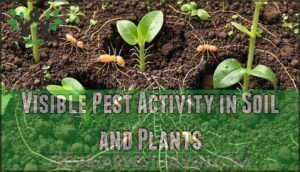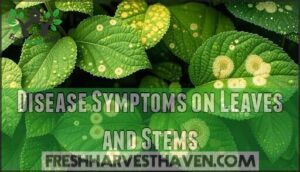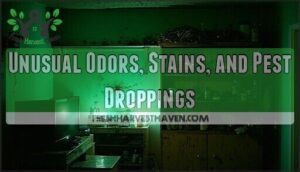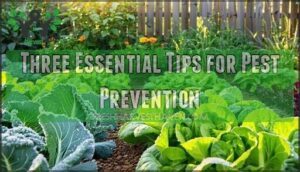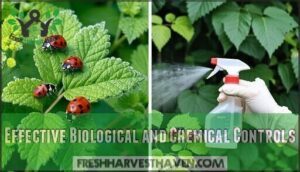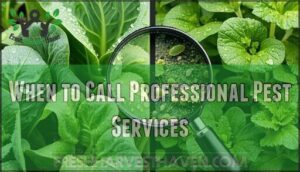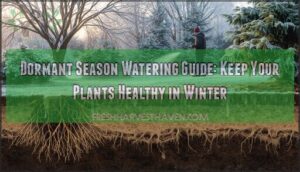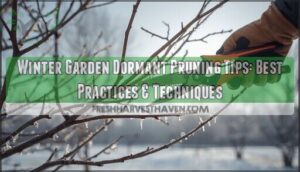This site is supported by our readers. We may earn a commission, at no cost to you, if you purchase through links.
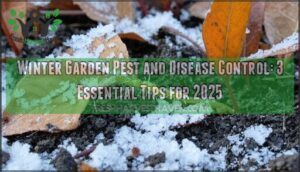
Staying ahead means seeing what’s hidden before problems take root. The right approach this winter keeps your garden—and your peace of mind—a step ahead. Here’s what winter garden pest and disease control really looks like for 2025.
Table Of Contents
Key Takeaways
- Winter pests like grubs, aphids, fleas, and ticks stay active or hidden in gardens and homes, requiring constant vigilance.
- Early detection of pest activity, disease signs, and unusual odors can prevent serious damage before spring.
- Effective prevention relies on regular cleanup, physical barriers, mulching, and ongoing monitoring for early intervention.
- Combining biological controls like beneficial insects with safe chemical options and maintaining garden biodiversity supports long-term pest management.
Top Winter Garden Pests to Watch For
Winter in the garden doesn’t mean your plants get a vacation from pests and diseases. Several troublemakers stay active or lie in wait beneath the soil, ready to cause problems when conditions favor them.
Let’s look at the key pests and diseases you should monitor this season.
Grubs, Stink Bugs, Fleas, and Ticks
Through winter, a handful of resilient pests threaten your peace of mind. Grub lifecycles slow beneath the soil but return strong when warmth comes. Stink bugs hunt shelter indoors, gathering by dozens behind walls.
Flea survival continues, thanks to heated homes and pets. While fleas can’t survive freezing temperatures outdoors, heated homes allow them to thrive.
Tick prevalence remains high where groundcover holds moisture. Each needs focused pest control and prevention now.
Aphids and Overwintering Insects
While grubs and ticks hang on in the cold, tiny aphids and other overwintering insects slip quietly into sheltered corners, always ready to return at the first sign of spring.
Winter Garden FL gardeners should stay alert—aphid life cycles don’t fully stop. Greenhouse infestations often start from unnoticed overwintering strategies.
Keeping an eye out during winter and using early biological controls are some of the best ways to stay ahead of pests at home.
Common Fungal Diseases (Downy Mildew, Powdery Mildew)
Just as aphids hide in plain sight, downy and powdery mildew quietly target your leaves. Mildew thrives in cool, damp spots, quickly taking over and leaving plants pale and sickly. One common sign is the appearance of white powdery growth on plant parts.
- Watch for white or gray patches—Mildew Identification.
- Know the Disease Life-Cycle so you can act fast.
- Choose Resistant Varieties for smarter pest prevention.
Identifying Early Signs of Infestation
Catching pest problems early can save your winter garden from serious damage. You’ll want to know what warning signs to look for before small issues become big headaches.
Here are the key indicators that tell you pests or diseases have moved into your garden space.
Visible Pest Activity in Soil and Plants
Ever spot something moving just beneath the surface or see leaves trembling when there’s no wind? Those are classic Soil Pest Signs. Inspect the base of plants for root infestations, pest egg masses, or larval tunnels. For ant control or termite damage, note soil treatments that discourage pest infestations in homes.
Look below for practical Plant Damage Clues:
| Visible Sign | What It Could Mean |
|---|---|
| Tunnels in soil | Root Infestations |
| Small holes on stems | Larval Identification |
| Clumped soil patches | Termite damage |
| Eggs near roots | Pest Egg Masses |
| Disturbed soil edges | Active Pest Activity |
Disease Symptoms on Leaves and Stems
As you walk your winter garden, look for yellow halos or dark centers—these are classic Leaf Spotting and early Necrosis Signs. Fungal Growth, like powdery white patches, signals Disease Progression.
Stem Cankers appear as reddish-brown wounds, hinting at deeper pest infestation. Catching these clues early lets you act fast, reducing health risks from pests and stopping a pest infestation in its tracks.
Unusual Odors, Stains, and Pest Droppings
Have you ever caught a strange smell or spotted odd stains where they shouldn’t be? Odor identification helps you spot early pest infestation. Dropping analysis and stain origins give away hidden pests.
Pest excrement—black specks or greasy marks—signals severity. Thorough pest identification and removal now makes pest control easier later, helping you prevent bigger pest problems.
Three Essential Tips for Pest Prevention
Pest prevention starts with a few smart habits that protect your garden all season long. If you want healthier plants and fewer surprises, some simple steps can make a real difference.
Keep these three key tips in mind as you start planning.
Sanitation and Garden Clean-Up
Clearing the clutter from your garden beds is like rolling out the welcome mat for healthy plants all season long. Regular debris removal and careful soil sanitation break pest cycles before they start.
Rinse and sanitize tools to curb spread, watch your water management, and don’t skip good composting practices.
Homeowners’ preventative actions here form the backbone of year-round pest control and management—even against termites.
Physical Barriers and Mulching
A sturdy layer of mulch and the right barriers can feel like drawing a line in the sand that many pests simply won’t cross. By choosing mulch types that improve soil health and barrier materials like garden fabrics or row covers, you give your home protection from invaders.
With steps like these, you’ll truly keep pests at bay and make your pest control efforts at home much more effective.
Monitoring and Early Intervention
The sooner you spot trouble in the garden, the better chance you have to stop pests before they dig in and do real damage. Regular inspections let you catch issues early, whether that’s a new pest infestation or the first signs of disease.
Spotting stressors early means you can step in right away with solutions and use a mix of smart strategies to keep pests under control and protect your plants.
Effective Biological and Chemical Controls
When pests or diseases threaten your winter garden, you have more than one way to fight back. Some solutions work with nature, while others offer targeted chemical defense.
Here’s how you can keep your garden healthy using both approaches.
Releasing Beneficial Insects (Ladybugs, Wasps)
Imagine turning your backyard into a tiny army camp, where ladybugs and wasps line up as nature’s own pest patrol. Ladybug consumption clears aphid populations rapidly, while wasp temperatures between 75–85°F make whitefly suppression effective.
Careful release timing helps, though most beneficial insects don’t create sustainable populations. Still, boosting biodiversity brings lasting pest control and stronger, healthier gardens for homeowners.
Choosing Safe Fungicides and Insecticides
Sometimes natural remedies get you most of the way there, but certain seasons demand a bit more.
When picking safe fungicides and insecticides, it’s all about balancing pesticide residue limits, organic choices, and the newest usage trends.
For your winter garden, organic sprays break down fast, while synthetic options linger but hit harder.
Always check for kids, pets, and label Safety Hazards before any pest treatment or insect control application.
Using Flower Strips and Hedgerows for Biodiversity
If you’re after a garden that holds its own season after season, growing strips of flowers or tucking hedgerows along the edge can bring balance where sprays leave off.
Attracting predators and enhancing pollination, these living borders create habitat and promote pest suppression, making sustainable gardening and pest management less of a hassle for homeowners serious about pest prevention and treatment.
When to Call Professional Pest Services
Sometimes DIY strategies just aren’t enough. When pests stick around, it’s time to think bigger for your garden’s safety. Here’s what to watch for when considering calling in the professionals.
Persistent or Widespread Infestations
How do you know when a few hungry insects have turned into a full-blown infestation taking over your space? Watch for signs like widespread damage to plants, persistent pests despite treatment, or obvious colony size growing week by week.
If you notice these warning signs—often triggered by environmental changes or recurring pest issues—it’s probably time to call in a pest control expert or exterminator.
Health Risks to People and Pets
Even a small pest issue can quietly lead to big health risks—for you and your pets. Some tick and mosquito bites carry diseases like West Nile Virus, Encephalitis, or Zika virus, while allergic reactions to stings are real threats. Pesticide exposure, fungal pathogens, and airborne allergens can also trigger respiratory risks.
Watch for:
- Unusual fatigue or fevers
- Skin rashes or wheezing
- Sudden allergic symptoms
Selecting The Right Local Pest Control Company
When pests get out of hand, finding a local company you trust can turn a stressful situation into peace of mind.
Look for pest control services with a strong local reputation, clear service guarantees, and proper licensing or insurance. Ask about free inspections, cost transparency, and treatment options.
Reliable commercial pest control and exterminator services help your home—and wallet—stay protected long-term.
Frequently Asked Questions (FAQs)
How can I safely store leftover pesticides?
“A stitch in time saves nine.” Always store leftover pesticides in original, labeled containers with tight lids, out of children’s reach. Opt for cool, dry areas.
Follow safe pesticide disposal methods to protect shelf life, homeowners, and pets.
What should I do after heavy rain in winter?
After heavy rain in winter, check your property for standing water and signs of soil erosion.
Remove debris quickly; pooled water and wet leaf litter attract pest havens, increase disease spread, and trigger new pest control problems for homeowners.
Are homemade remedies effective for garden pest control?
Like a patchwork quilt, DIY efficacy in pest control is pieced together—some remedies help, but many lack lasting results or safety for plants.
Choosing a professional takes the guesswork out of pest control, delivering more effective results and saving you money over time.
How do I protect pollinators during treatments?
Choose pollinator-safe pesticides and use targeted application, avoiding blooms where bees visit. Adjust treatment timing to early morning or dusk.
Preserve habitat by leaving wildflower strips—these bee-friendly practices support strong pest control and responsible insect control.
Can pets be in the garden after spraying?
Freshly treated beds may seem harmless, but Spray Residue Risks linger. Always check the product label for Pet Re-entry Time.
Breed Sensitivity Matters, so play it safe—limit your pets’ Plant Contact Danger after pest control services.
Conclusion
Only 25% of overwintering pests survive a well-maintained garden, so every step you take this season sharply reduces spring problems. Winter garden pest and disease control isn’t just a chore—it’s your best insurance for healthy plants.
Keep eyes open for subtle signals, clear away hidden shelters, and act early. When you’re watchful now, you’ll greet spring with thriving beds instead of surprise infestations. In winter, quiet vigilance makes all the difference for your garden’s future.
- https://www.catseyepest.com/blog/winter-pest-control-garden-yard/
- https://extension.psu.edu/embrace-the-cold-it-is-likely-to-restrict-some-pest-species-populations/
- https://hartley-botanic.co.uk/magazine/using-biological-controls-greenhouse/
- https://www.vegetables.cornell.edu/pest-management/disease-factsheets/diseases-occurring-in-winter-greens-and-their-management/organic-disease-control-in-winter-tunnels/
- https://pmc.ncbi.nlm.nih.gov/articles/PMC8540207/

